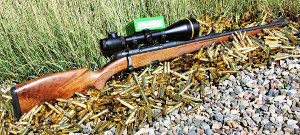
The over 100 year old American Classic- the 30-06- is the number one hunting round in the US, and is also very popular in Europe and Africa- for very good reason. There is not much game in the world, save for African dangerous game, that cannot cleanly be taken with a 30-06 and good bullets. The first in a new series- The American Classics- takes an in-depth look at the workhorse caliber of the world; with a slight twist- all loads will feature lead-free projectiles.
I still have many more cartridges to cover in my Magic Metrics series, but the recent interest in lead-free hunting bullets prompted me to start my new series-The American Classics- with the world-famous 30-06 cartridge. While tons of loading data abounds for traditional cup and core bullets, I wanted to take a twist and round up all of the hunting bullets made of a homogenous metal but designed for expansion, unlike the monolithic solids used for heavy dangerous game like Cape buffalo, elephant, or even hippos. I will not delve into a long history, as everything possible since 1906 has already been covered again and again on this cartridge.
Due to the popularity of the 30 caliber, it has been blessed with many long existing and some recent to very recent new additions to expanding monolithic hunting bullets. Recent additions include: the Hornady GMX (Gilding Metal Expanding), the Nosler E-Tip, the less recent Lapua Naturalis, and the over 20-year veteran line of Barnes X-Bullets in both the TSX and TTSX (tipped TSX) versions. A very unusual bullet was also included- the Barnes MPG, for Multi-Purpose Green, was designed to offer a ricochet-proof projectile for safe engagement of steel targets. Its compressed
powdered metal core does offer some limited possibilities for strict hunting applications; but more about that later. Every reader, shooter, and hunter will find loads here they can readily take to the field with guaranteed success.
Chapter 1: The Test Rifles
Click to LOAD DATA SHEET
I am very partial to the Steyr-Mannlicher offerings, as time and again I am rewarded at the range with excellent results from the vast majority of the loads I develop and trial. Two rifles were used for these tests due to the very great amount of shooting I anticipated...
doing. I was testing 16 bullets and 17 powders. All told, over 1,600 rounds were loaded and fired for accuracy. The first rifle is my own personal 20” full stock Classic, chosen for the unique and beautiful appearance of its wood. The factory test target was not extraordinary- around 1” for a three-shot group using factory ammunition. That proved to not at all be a very accurate indicator of how capable it really was, with many loads shooting into one-half to one-third that spread.
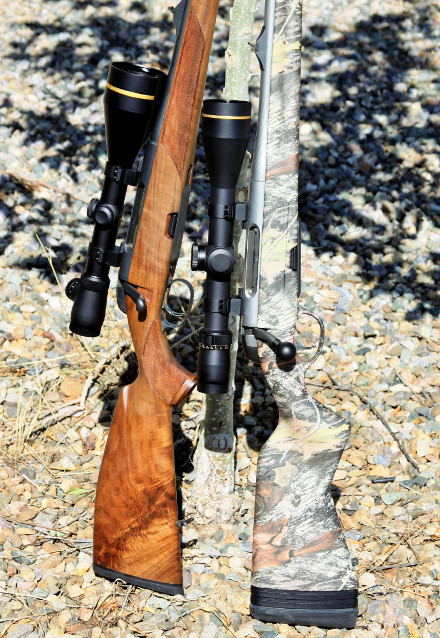
The second rifle was one of the new Pro Alaskans of stainless construction and having a soft-touch camouflage stock and a fast-response bolt handle. As a bonus, its longer 23.6” barrel would provide for an interesting comparison of velocity gain versus the shorter full stock. The Classic wore a new Leupold VX-3L in 3.5-10x56mm, having an illuminated Boone and Crockett reticle; the Pro Alaskan was topped with a high-end VX-7 in 3.5x14x50mm. Both clearly allowed me to see all bullet holes in the targets at 100 yards, saving me the time of going back and forth between my rifles and a spotting scope. The VX-3L for certain has found a permanent home on my full stock; my 300 Win Mag may be the new home for the VX-7.
Twenty to twenty-five rounds were fired at a time, thereafter cleaning with Barnes CR-10 and an Iosso synthetic brush (MidwayUSA), followed by dry cleaning patches. Normally, I fired only two or three, 3-shot groups with each rifle before going to the already cooled, previously fired gun. On several occasions, I pushed things a bit and shot a fourth 3-shot group. The results? Using the Barnes 150-grain TSX FN, meant for the .30-30, my third group propelled by H322 measured less under 3/8” and was immediately followed by a similar-sized group loaded with H4198, all fired down a very hot barrel. Results like that greatly please me, especially when obtained from the short, Classic full stock.
Chapter 2: Reloading Components Tested
Lapua provided the 300 brass I used for these tests. I am very impressed with the quality and consistency of their product and will use it again whenever possible. All cases saw it...
through five or six loadings without a whimper. Loads featured CCI large rifle primers to ignite both stick and ball powders. Loading was done on my Redding UltraMag single stage press with Redding FL dies using their sizing die wax. Four brands of powders were tested as follows: VihtaVouri, Hodgdon, IMR and Winchester. Specific ones chosen based in QuickLOAD recommendations included- N530, N540, N550, N150, and N560; H4198, H322, Varget, H4895, H414, and H4350; IMR 4198, 3031, 4064, 4895, and 4350; Win 760.
All homogenous bullets were seated .035 to .050 off of the rifling; the somewhat more conventional Barnes 140-grain MPG was .015 off the lands. A Hornady L-N-L O.A.L. Case Gauge was used to determine the overall length at which all bullets touched the rifling- I would never be without this most valuable tool. I would fire two or three, 3-shot groups with one rifle, and then grab the previously shot rifle which, by then, had cooled to a large degree.
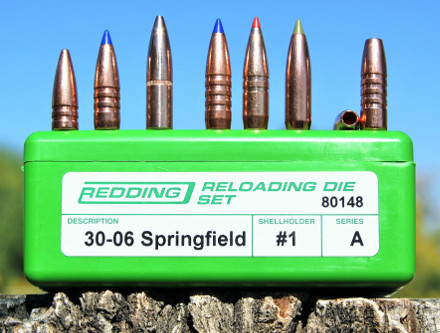
The Steyrs impressed me again and again. After a good cleaning, the first shot out of the barrel stayed right in the group made by rounds two and three. This is a great feature on the range and especially in the field. I typically shot three to four hundred rounds for accuracy when at the range. Velocities for each load were verified in both barrel lengths, making for an interesting comparison. Bottom line- a hunter need not feel handicapped at all with the shorter barrel of the Classic full stock carbine!
From Hornady, I obtained their brand new GMX bullets in 150 and 165 grains. The bullets are made of the same gilding metal as is used in their traditional soft-point projectiles. Nosler uses an alloy for their 150 and 180 grain E-Tips, which is similar to that used for the Partition and AccuBond bullets. The Lapua Naturalis, which have been around for several years, are of copper construction with bright green plastic tips in both the 170 grain Long Range bullet and the 180 and 200 grain round nose versions. Note that both Hornady and Nosler also make use of pointed plastic tips in their bullets. The GMXs have two grooves cut into the body, the Naturalis only have one, while the E-Tips have none...
at all.
Barnes has been making all-copper expanding bullets for over twenty years in several variations. The current seems to be the most consistently accurate ever offered, with the Tipped TSX (TTSX) shooting very well in all weights and having from two to four grooves. From the largest and longest producer of expanding homogenous bullets I obtained Barnes: 110 grain TSX, 130 TTSX, 150 TTSX and the TSX FN (flat nose) meant for the classic .30-30 round, a 165 MRX (Maximum Range X) with tungsten-based rear core, the 168 TTSX, 180 TTSX, and the 200 grain TSX bullet. I also got some of their 140 grain MPGs; a conventionally jacketed bullet but with a compressed powdered metal copper-tin core. This bullet was designed to eliminate ricochets when engaging steel targets in competitions. They deliver explosive fragmentation on impact with the core returning to a dust state upon impact. The bullet performance lends itself to the potential application in very specific hunting situations.
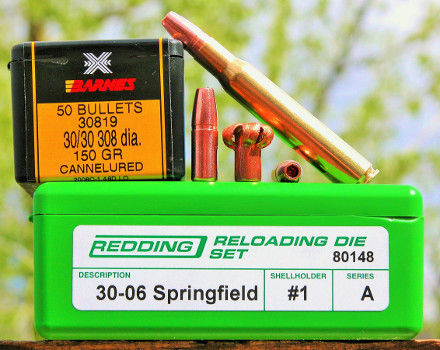
Noting the significant neck length of the 30-06 case, I also gave it a go and tried to apply my duplex technology learned from working with revolver cartridges, loading TWO of the 110 grain Barnes bullets back-to-back with impressive results.
Chapter 3: Expanding Monolithic Advantages
There are four distinct advantages to a hunter when using an expanding monolithic bullet instead of a conventional soft-point. #1- Increased straight line penetration to ensure reaching the vitals if things do not go perfect; #2- Improved tracking ability from almost certain exit wounds, vastly improving recovery of game; #3- Ability to use lighter weight bullets to meet or exceed the penetration of a conventional soft-point bullet resulting in a flatter trajectory and lower recoil- both of which will be of benefit to a hunter in placing their shots; #4- Reduction in the loss of meat due to “bloodshot”. They all relate to the superior performance of a projectile made of a homogenous material that is designed to perform.
If you take an eight foot 2×4” and bend it, it will break in a somewhat random fashion. If you first place a very light cut in the middle of...
that board then bend it outwards, it will break at the light cut in a controlled, predictable manner. Conventional soft points can come apart in varying degrees depending on impact velocity and tissue encountered. At times, their performance can be good; at other times, their unplanned failure can result in the loss of an animal.
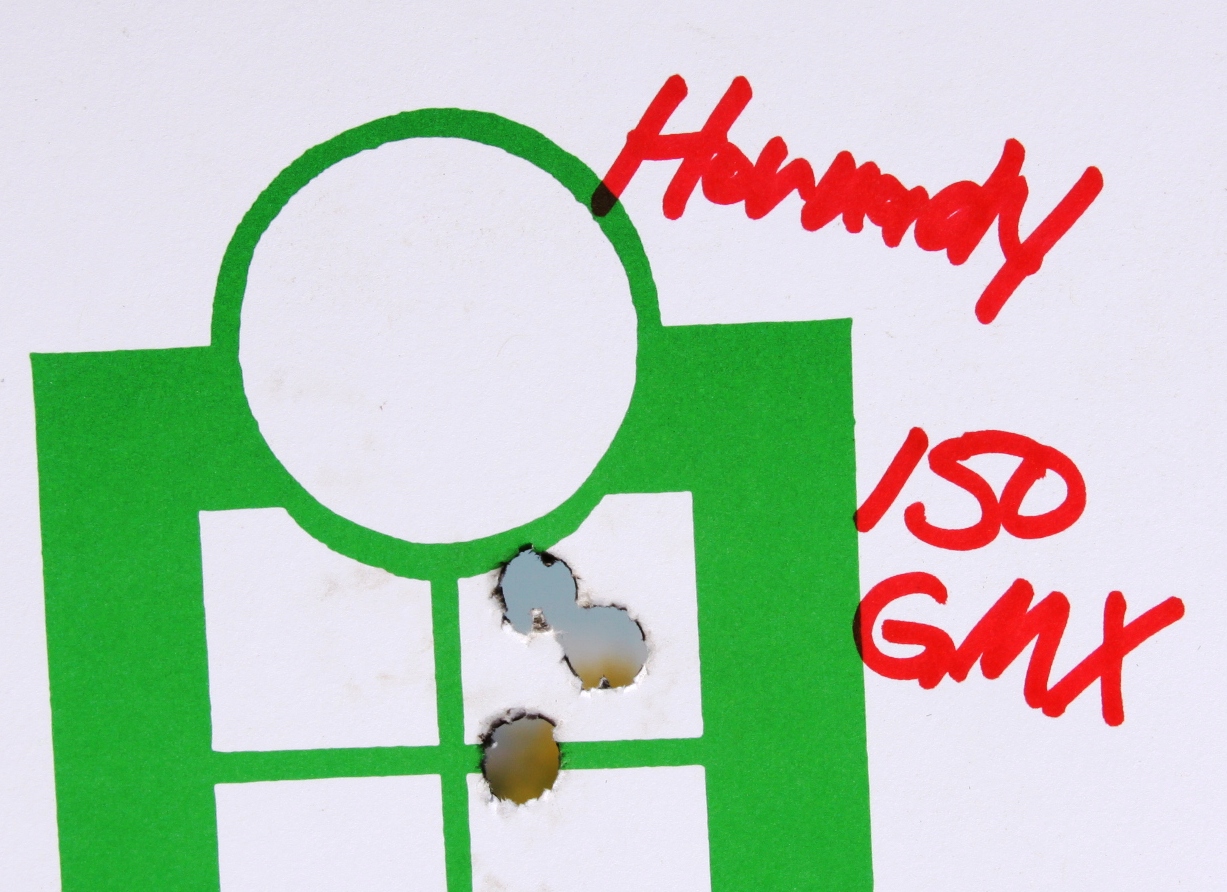
With an expanding monolithic bullet the nose portion, which does the “work”, is engineered to expand in a controlled fashion at both high and low impact velocities. Expanding monoliths typically will retain well over 90% of their weight, minimizing bloodshot meat. They do not come apart like a soft-point, which often is the reason for excessive meat loss, as jacket and core break apart after impacting game. If
a soft point is going too fast for its construction, it can blow to pieces if the stresses become too great. Penetration will be greatly limited and the vitals may not even be reached.
Should an expanding monolithic bullet be stressed too hard, at worst some of the front expanded portion may shear off, leaving the vast majority of the bullet weight to continue on to penetrate to the vitals and even beyond. In a “perfect world” of hunting, most any bullet will suffice for a moderate distance shot at a broadside stationary animal with perfect shot placement. But… what if the distance instead is suddenly at point-blank? What if the animal turns at the very moment of the shot? What if your shot is less than perfect… or even far from perfect? Will a fast expanding soft-point’s maximum energy transfer always coincide with the target’s vitals? Maybe…or maybe not.
As an ethical hunter, I want to know that the vitals can and will be reached from even a difficult angle. I want an exit wound. If my shot is poor for whatever reason, exit wounds make tracking and recovery of game far more certain. I want to be able to recover my game if things did not go well at the shot, and I especially want my family to enjoy the venison I have harvested.
Testing recently performed by shooting into ballistic gelatin, proved what I have already seen in the field for almost twenty years when using expanding monolithic bullets. A...
conventional 150 grain soft-point bullet and a 130 grain Barnes TTSX were both loaded to 2,851 fps and shot into gelatin at 100 yards. The soft-point retained almost 75% of its weight, but the lighter TTSX retained 99.8% and delivered over 30% greater penetration. The 150 grain bullet was loaded under a full charge to hit that speed, producing full recoil levels; to deliver the same velocity the 130 Barnes was loaded as a MEL (Moderate, Effective Load) resulting in the recoil level of a .243. Now imagine loading that same 130 grain TTSX up to 3,200 fps, and see what it can do on game in the field..
Chapter 4: Results and Recommendations
Sixteen bullets were tested, each with at least twelve different powders, resulting in over two-hundred combinations. I cut off reporting loads that shot over 1-1/4” for three shots at 100 yards, resulting in right around the one-hundred and fifty listed combinations. If a bullet is shown with a dozen powders, it was not very sensitive to propellant choice, ensuring you should easily find a match for your rifle to also shoot very well. If only a few combinations are shown, then you may have to work to get that bullet to shoot well for you. That speaks quite well, in general, as far as the overall accuracy of the bullets, and of course for the rifles.
Sixteen bullets were tested, each with at least twelve different powders, resulting in over two-hundred combinations.
Obviously, I cannot discuss all of the loads but wanted to ensure the highlights are covered. Starting with the 130 grains Barnes TTSX, I impressively harvested a 150 lb. wild boar in Texas, broadside at around 50 yards using the load with H4895, delivering 3,190 fps from the short barreled Classic full stock. We always hear how tough the gristle plate is that covers both shoulders of a boar to protect them when fighting. The 130 grain expanding monolithic bullet broke the near shoulder blade, broke through the backbone, broke through the far shoulder blade, and exited. When the hide was removed, I could see a ½” or so hole completely through the boar. As the bullet had not fragmented, meat damage was minimal beyond the immediate wound channel.
Very accurate (1/2”) and effective MELs were realized using H4198 using the 130 grain Barnes. 0.59” groups were produced when using N530 for 3,048 fps. The top loads almost reaching 3,300...
fps for the 20” full stock, used either Winchester 760 or IMR 4064, shooting into 0.63” and 0.71” respectively. A new bullet weight, the 110 TSX, would probably work very well on lesser game, considering the 130’s performance on boar. Especially low recoil MELs used either H4198 or IMR 4198, with the most accurate full-power load reaching 3,228 fps when loaded over IMR 4320. The 140 grain Barnes MPG may have hunting applications for a professional hunter needing to control animal numbers without the risk of exiting bullets wounding unintended game. With great attention to its limitations, a very effective low recoil and quiet load used 43 grains of H4198, for 2,876 fps, while shooting into only 0.75”.
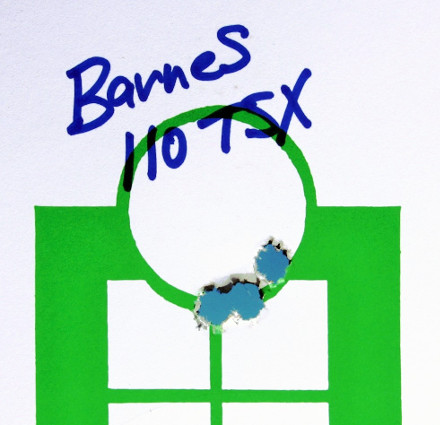
Based on the performance of my favorite 130 grain load at a weight of 150 grains and above, I would expect a hunter to see complete penetration of most medium game at least on broadside shots with all of the following heavier bullets. The Hornady 150 grain GMX shot very well at 0.59” and 0.67” respectively, shooting with a MEL at 2,657 fps and a full power load that reached 2,808 fps using N540. The Nosler 150 grain E-Tip was selective as to the powders it liked, shooting around 1-1/8” or less over H322, H4895 or 760. With the 150 Barnes TTSX, an outstandingly accurate MEL delivered an average of 3/8” groups when loaded over H4198. In total, four low recoiling loads were developed with this bullet, which all would be great for introducing a new hunter to the sport. Two standout full power loads used IMR 4895 and H4895 to reach right at 2,930 fps from the Classic, shooting into 0.67” and 0.75”.
The 150 grain TSX FN is meant for the American favorite .30-30 in a lever gun; I have used it with great success in the field in both the 308 and the 30-06. To date, I have taken nine head of game with it, and all have fallen to the shot. Only one was taken in the spine, the others were broadside, double lung shots. One day at the range, I shot consecutive sub 3/8” groups as MELs over H322 and H4198. A near full-power load with this bullet uses Varget for 2,841 fps and 0.67” groups. 55.7 grains of N550 drove it to over 3,000 fps from the 20” Steyr. I would expect awesome...
performance on big game with this load, out to 200+ yards.
Again, N550 gave almost spooky performance when loaded with the 165 grain Hornady GMX, rewarding me with less than 3/8” groups at a speed of almost 2,800 fps from the short barrel, and 2,858 fps from the longer Pro Alaskan. With this load, I would be confident to well past 300 yards on most American or African plains game. H4198, IMR 4320, N530, and Varget all gave very accurate results under this heavier GMX bullet. In fact, all nine powders listed shot between 0.31 to 0.94”, indicating a great lack of sensitivity to powder selection with this Hornady. Similarly, both the 165 and 168 Barnes bullets each are listed with a dozen propellants. Particularly good performances were obtained using H4198, H4895, H4350, H414, and N550.
At ten yards, both were still back to back, as only one hole would appear in the paper.
The Lapua Naturalis in the 170 grain Long Range version, shot into 0.47” using IMR 4895, and 0.75” with H414, while the bigger 180 and 200 grain round nosed brothers did well with IMR 4350, H4350, and H414. I have shot the Naturalis bullets to check for expansion into a water tank. They held together well at full power loadings and still
expanded nicely when loaded as MELs. The heavier round nose version should be great for large game in the woods.
Much better accuracy was obtained, and with a broader variety of powders, when loading the heavier 180 grain Nosler E-Tip bullet, vs. the lighter 150. A MEL using IMR 4198 delivered 0.94” groups, and full power loads at around 2,600 fps shot into 0.55” and 0.75” using H4895 and H4350. The 180 grain Barnes TTSX shot well with virtually all powders tested, from low recoil MELs to full power loads, 49.1 grains of N150 reached 2,630 fps in the short barrel, and produced 0.75” groups. The Barnes 200 grain TSX looks almost as long as a short golf pencil, but it still stabilized well in the Steyr’s 1 in 10” twist barrels. Two MEL loads shot into 0.59” and 0.71”, while an almost full power load using IMR 4350 delivered 2,338 fps with 0.55” groups. Again, N150 also was very accurate at 0.75”, giving the 200 grain bullet 2,367 fps.
...
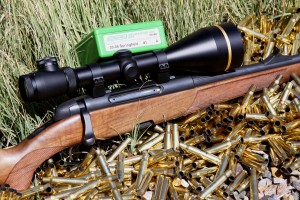
Lastly, realizing what a very long neck the 30-06 has, I had to try a duplex load using two 110 grain Barnes TSX bullets loaded back to back. When I loaded 45.4 grains of H414, it produced 2,217 fps from the short barrel, and 2,296 fps from the long, with one bullet flying point forward, the other backwards. At ten yards, both were still back to back, as only one hole would appear in the paper. Moving back to 25 yards, the bullets had separated slightly, being around 1/2 to 5/8” apart. At 100 yards, three shot groups (launching six bullets) were in the 4 to 5” range- but sometimes the paired bullets were only 2” apart. This might make for a very interesting finishing shot on boar, as up close, you basically have a 220 grain expanding bullet that instantly become two 110 grain fragments- one of which will expand, while the other acts as a flat-point solid.
Chapter 5: Summary
For many years, I avoided the 30-06 like the plague. It was too “common” to suit my tastes. I always wanted something faster or bigger with which to play and hunt. I even thought the 30-06 was only for “old guys.” As a result, my safe kept filling up with rifles that may have only varied by fractions of an inch or a couple of hundred fps. Now, I am very much wiser- there truly is a benefit to owning and using a gun that can do it all.
As stated in the beginning, I wanted to take a fresh look at a cartridge I have come to appreciate as a noble workhorse. The recent growth of monolithic expanding bullets
aroused in me a desire to see what a 100 plus year old cartridge can do with the latest and greatest advancements in projectiles. The bottom line is, once you pull the trigger, it all comes down to what the bullet will do when it gets there. After many years of hunting game in tremendously varying conditions, I have come to realize that it matters not whether the bullet is 270, 7mm, or 30 caliber, or that it weighs 130, 160, or 180 grains. What really matters is how your chosen bullet performs once inside your game.
A truly good bullet design in any of these calibers, in a weight matched to the size of...
game being hunted, will do the job. I used to lean towards the faster, smaller bores on lighter game, jumping up to a big gun for heavier quarry. Looking at how my beautiful Classic full stock performed on a boar with the 130 grain Barnes, I smile to think of what a 150 or 165/168 could do on the largest of game. Barnes says they make the heavier weights because that is what hunters want to load in their rifles; it’s what they are used to.
Please consider the advantages expanding monolithic bullets can offer a modern hunter, and when loading for your 30-06, be open to stepping out of the traditional-weight rut. As much as I love my very traditional Steyr full stock, I see advantages when the weather is foul to grabbing the camo synthetic, stainless Pro Alaskan instead. With a very broad range of bullet weights from which to choose, one truly can find a load to hunt anything from mice to moose if you wisely choose a 30-06 as your main and only hunting cartridge.